Leaf Feeders
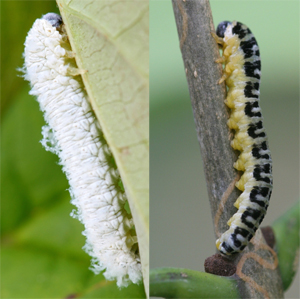
David Cappaert, Bugwood.org
Dogwood sawflies are caterpillar-like wasp larvae that feed on tree leaves. Their appearance changes as they develop. Partly grown larvae appear to be covered with a white, chalky powder. When full grown, they are cream-colored with a shiny black head and black spots. They may be found from May thru July.
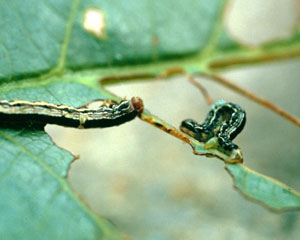
A. Steven Munson, USDA Forest Service, Bugwood.org
Fall cankerworm is a looper caterpillar that can vary from light green with yellow stripes to green with a dark stripe down the back. Overwintering masses of about 100 eggs hatch in later April or early May; small caterpillars chew small holes in young leaves at branch tips. Larger loopers leave only the midrib and major veins. Fall cankerworms are about an inch long when full grown. Mature larvae descend from trees on silk threads to pupate in the soil. They emerge as adults during periods of freezing temperatures to mate and lay eggs on host plants. There is one generation each year.
Sap Feeders
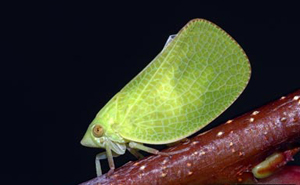
Susan Ellis, Bugwood.org
Leafhoppers are small, light green, active insects that live on the underside of the leaves. They use sucking mouthparts to feed on plant sap. Usually large numbers are present by the time the injury is obvious. Heavily damaged leaves may drop early but this insect usually does not cause serious problems
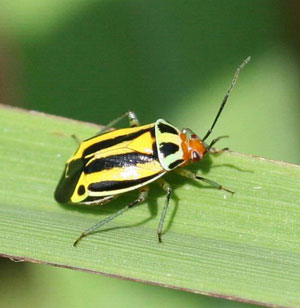
Johnny N. Dell, Bugwood.org
Four-lined plant bug adults are between 1/4-1/3 inch long, have an orange head and yellowish body with four black stripes running down the back. The nymphs are red to red-orange with black dots. There is one generation per year, with feeding and growing occurring in May and June. As they feed, four-lined plant bugs create circular brown-black spots. The spots are about 1/16-inch wide and can merge together to create a blotchy appearance that resembles a disease issue. The damaged spots can also dry and fall out of the surrounding healthy tissue, leaving a hole behind.
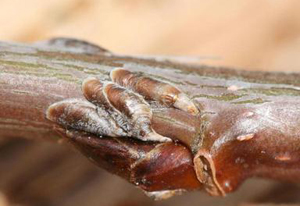
Whitney Cranshaw, Colorado State University, Bugwood.org
Oystershell scales are about 1/10 inch long and resemble crusty accumulations of oyster shells on the bark. Their drab, bark-like appearance makes them easy to overlook, even on close inspection. Heavy infestations can kill twigs or branches. This scale overwinters in the egg stage under the waxy covering of the female. The eggs hatch and the crawlers are active from late May to early June.
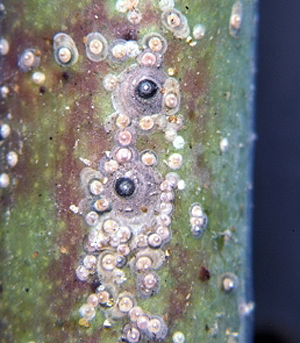
United States National Collection of Scale Insects Photographs,
USDA Agricultural Research Service, Bugwood.org
San Jose scale is one of the most destructive scale species. Infested stems, twigs or branches may be killed and heavily infested trees may die. These small circular brown armored scales have a series of dark concentric rings on their waxy covering. There are several generations each year. First crawlers are active from late May to early June, a second generation appears in late July and a third in late summer or early fall. Heavily infested plants may have a crusty covering of scales.
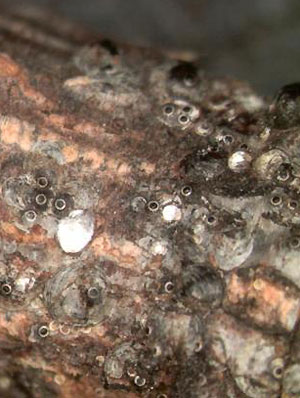
Lorraine Graney, Bartlett Tree Experts, Bugwood.org
Gloomy scale is an armored scale commonly found on red and silver maples. It can be found on many other plants, including sugar maple, boxelder, sweet gum, hackberry, and more. Research at North Carolina State University has shown they are more common in urbanized areas. The waxy covering of gloomy scale blends in with tree bark but does have a pale ring to distinguish it. Symptoms of heavy armored scale infestations are branch dieback and a thin canopy. The immature form of these scales is called a crawler and is the most susceptible stage to control. Gloomy scale crawlers begin emerging in May.
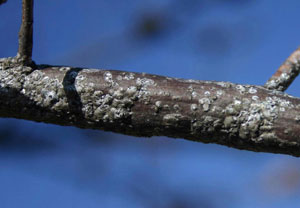
William Fountain, University of Kentucky, Bugwood.org
Obscure scales are important armored scales that can infest oak, hickory, walnut, maple and willow. Heavy infestations can be found on stressed oaks in urban settings and may cause branch dieback. Infestations of obscure scale rarely kill a tree but can weaken it and make it more susceptible to other problems. There is only one generation a year. Females lay eggs from June into August with peak crawler activity occurring around mid-July. Newly hatched crawlers tend to settle under covers of mature scales, producing crusted layers on severely infested limbs. The dirty gray wax covers of females, about 1/8 inch in diameter, blend in with the bark. For more information, see Entfact 432.
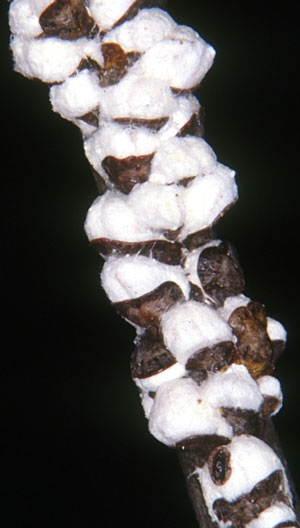
Cottony maple scale is a soft scale that infest maples, boxelder, basswood, birch, elm, and linden trees. This species overwinters as a small immature form and moves to find feeding spots in the spring. By June individuals become mature and egg sacs become noticeable. The eggs hatch in June or July and immature crawlers move to leaves to feed. As autumn approaches, they will move toward bark for winter protection. The adult female scale is 1/8 inch long, brown, and oval. Symptoms of an infestation include dieback, large amounts of honeydew, and black sooty mold.
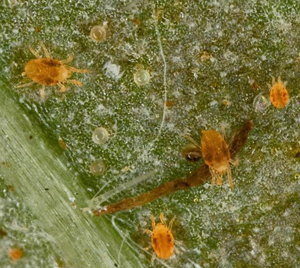
David Cappaert, Bugwood.org
Twospotted spider mites are tiny (1/50 inch) arthropods with a dark spot on each side of the oval, light green to yellow body. They live on the underside of leaves and use needle-like mouthparts to remove the contents of individual cells. This produces tiny white to yellow spots on leaves, sometimes called flecking or bronzing. These mites produce fine silk-like webbing that often covers infested plants. Infestations are usually most serious during hot, dry periods.
Borers
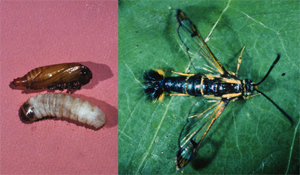
J.A. Davidson, Univ. Md, College Pk, Bugwood.org (larva, pupa)/
David Laughlin, Horticultural student, Bugwood.org (adult)
Dogwood borers are white caterpillars with yellow heads that feed beneath the bark and produce a sawdust-like waste that accumulates at openings on the bark. Infestations usually develop at or around wounds in the bark.